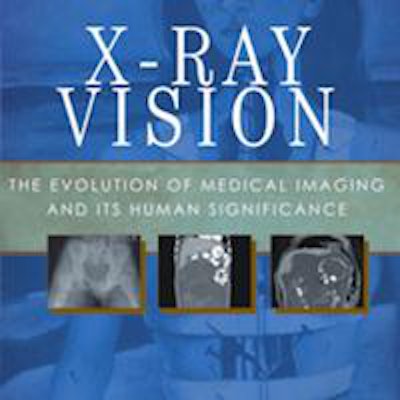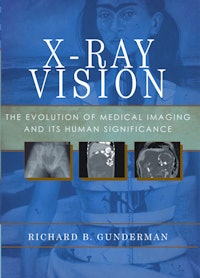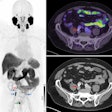
Surgeons and anesthesiologists can speak tantalizingly about a person's femoral artery gushing blood onto the ceiling, or a child's throat closing after eating a peanut, and how they heroically rescued the patients from crossing St. Peter's gate, with resounding applause at a cocktail party.
Radiologists are primarily informers, not interveners, and it's not every day you can say "the region of interest on the mediastinal lymph node registered 80 Hounsfield units. I diagnosed Bacillus anthrax and alerted the nation to a major biological attack from Agent Snowden."

Explaining how radiologists steer the clinical course from an ill-fated outcome, elevating us from innominate to central players, is an art the profession needs to master. Few have mastered it as well as Dr. Richard Gunderman, PhD, whose latest book, X-Ray Vision: The Evolution of Medical Imaging and its Human Significance (Oxford University Press, December 27, 2012), is replete with richly told stories that explain the value of imaging and radiologists.
However, exquisite narratives are only a part of this wonderful read, which is a historical tapestry of radiology, philosophy, art, humanities, and modern literature, showcasing a breadth of rare erudition.
Gunderman chronicles assassination attempts on three U.S. presidents: James Garfield, William McKinley, and Theodore Roosevelt. Their relevance to imaging -- though not immediately intuitive -- is unmistakable.
Garfield and McKinley died not from immediate effects of the injury, but from delayed complications of superimposed infection that might have been prevented had the bullet been localized and removed.
In Garfield's case, there was a concerted effort to find the bullet, which included the use of a metal detector. Garfield died 80 days after the assassination attempt, and it's likely that if an x-ray system was around, the bullet would have been removed and he would have survived.
McKinley sustained severe abdominal injuries and died somewhat sooner, within nine days of the attempt. Neither Garfield nor McKinley had the option of x-rays, but Roosevelt did, and it was decided that the bullet should be left alone because it was too close to vital structures. Roosevelt lived.
Garfield would have survived because of x-rays, McKinley might have died despite x-rays, and Roosevelt survived with x-rays. Imaging can be instrumental to the clinical course, or incidental.
The chapter "Slices of Life" features the story of "Little Ritchie," whose appendix perforated because of a delay in diagnosis, bringing him perilously close to death's door. This was before the advent of CT. Little Ritchie was none other than Ringo Starr, the drummer for the Beatles.
The Beatles, of course, were the predominant reason for the success of Electric and Musical Industries (EMI). EMI, hardly constrained for money, funded an off-the-beaten-track project of its engineer and genius Godfrey Hounsfield, a project that led to the first CT scanner. An undeniable benefit of CT is in the prompt diagnosis of acute appendicitis. Thus, in a reverse karmic plot, a potential beneficiary of CT became, unintentionally and indirectly, its benefactor.
Gunderman reminds readers that radiologists are not just arithmeticians and number crunchers, but physicians who often rely on judgment and experience. In an era in which one yearns for even more quantifications, probabilities, and guidelines as emollients for all uncertainties, when a case can be made that one does not need a medical degree to use a caliper proficiently, it is radiologists who would do best to heed his message.
 Dr. Richard Gunderman, PhD.
Dr. Richard Gunderman, PhD.
Gunderman's breadth of knowledge extends into modern literature, from which he draws several instances where imaging is mentioned with reverence or ambivalence. Most memorable are lines from Thomas Mann's The Magic Mountain, a story of a tuberculosis sanatorium: "The sounds that the doctor can hear tapping my chest are only the acoustic indicators; real diagnostic certainty we shall only arrive at when I am about again, and the x-ray and photography have taken place. Then we shall have positive knowledge." We are talking about plain radiographs! Clearly, whispered pectoriloquy had little chance against high-resolution CT.
The author has a penchant for subtle but appropriate metaphors for the strengths and weaknesses of imaging. The father of x-rays, Wilhelm Roentgen, blind in one eye and also color-blind, encapsulates modern-day imaging, which often sees more than it can make sense of and suffers from its own color-blindness: the frequent inability to distinguish health from disease, leading to overdiagnosis.
Gunderman compares radiologists to the Oracle of Delphi, a comparison that seems apt in some ways but wishful in others. Men seeking information to improve their decision-making received advice, though it was given in general terms that could never be wrong (the ancient version of "cannot be excluded"); there also was no obligation to follow the advice or a need for clarification by more specialized oracles -- i.e., further oracles were not recommended.
Clearly, for radiologists, the supply of oracular pronouncements must be tempered by their usefulness and the likelihood that the advice is actually taken; considerations that did not afflict the oracles of ancient Greece and Rome.
Our profession has been blessed with its own Sibyls writing lamentations on the decline and fall of the imaging empire if our trajectory does not change. A recurring theme -- and Gunderman does a fine job of underscoring the point -- is that radiologists must move beyond the image, beyond the TR and TE and the flip angle, to the story behind the image, which is the story of our patients, to restore humanity to technology. This is a very humbling message. Indeed, there is no getting away from it. It came with our Hippocratic oath.
In fewer than 214 pages, an astonishing breadth of material is covered, including the role of x-rays in the detection of fraudulent art, the cause of death of the mysterious medieval Lindow Man, and the controversial omission of Dr. Raymond Damadian from the Nobel Prize recipients for the development of MRI.
For aficionados of medical history and collectors of medical trivia, this is a delightful read. But every radiologist should give a copy to a nonphysician friend. I cannot think of a better exercise in public relations for the profession.
Dr. Jha is an assistant professor of radiology at the Hospital of the University of Pennsylvania. He is a superspecialized cardiovascular imager but will grudgingly admit that he is really just a general radiologist who likes the heart more than the posterior fossa.
The comments and observations expressed herein are those of the author and do not necessarily reflect the opinions of AuntMinnie.com.



















